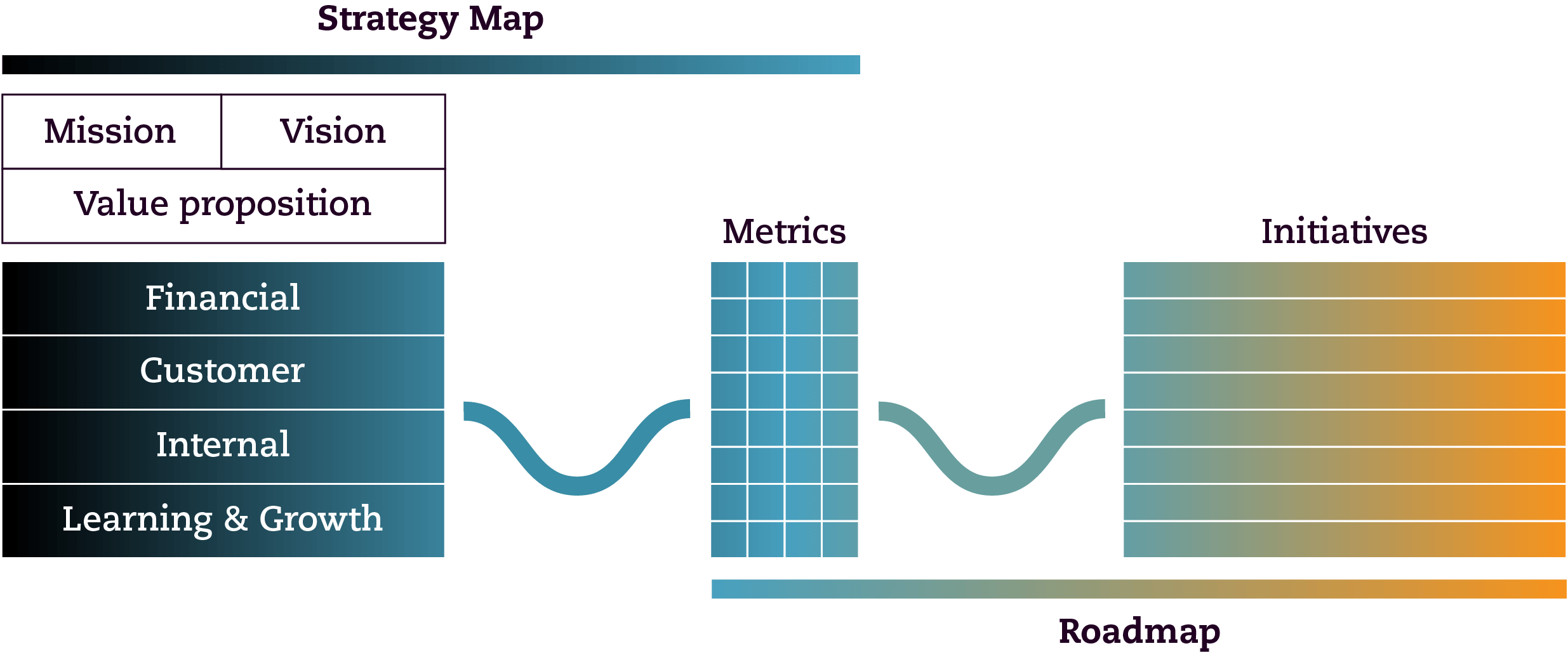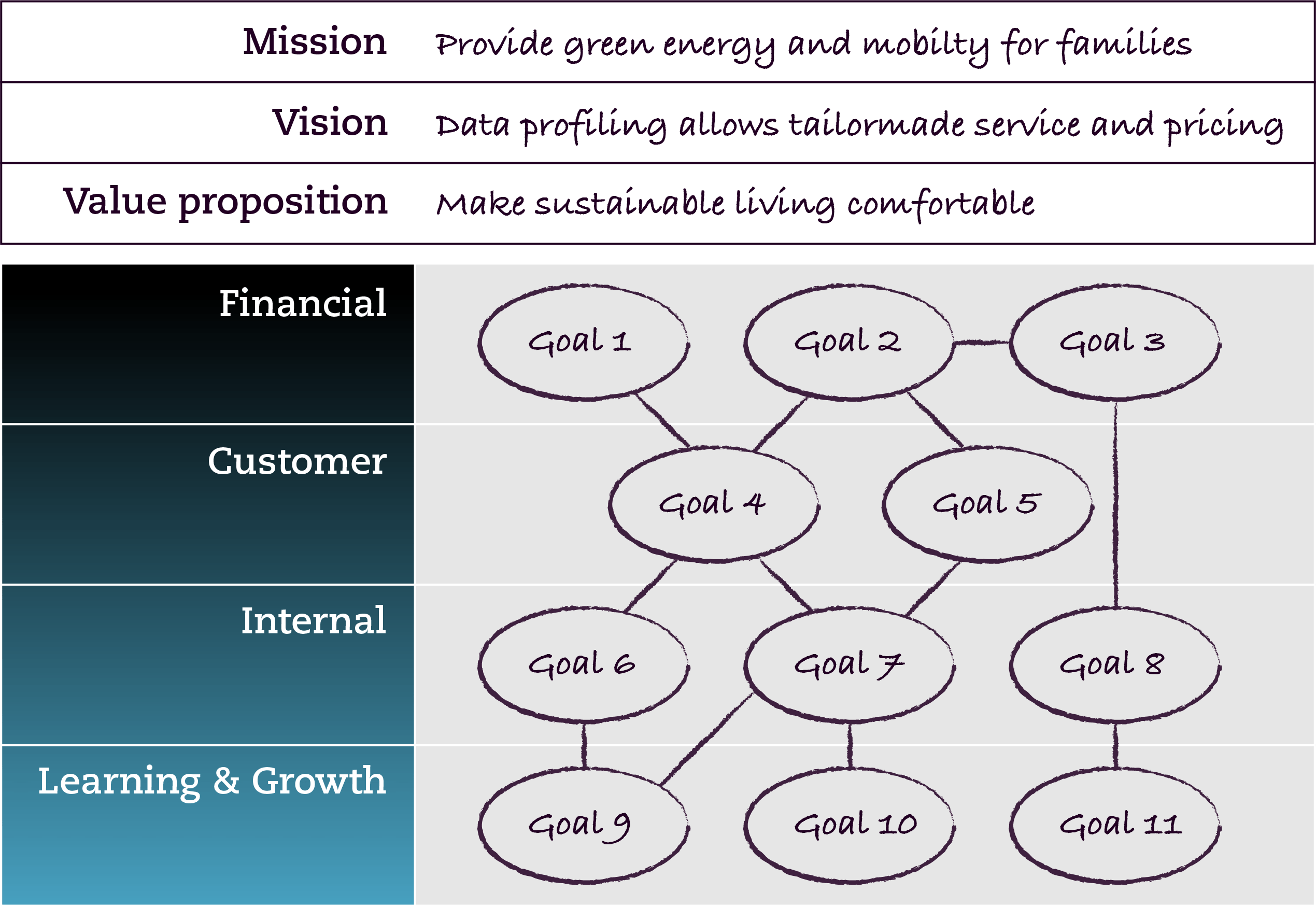The Power of a Strategy Map: Aligning Business and Development
In today’s fast-paced business environment, it is essential for organizations to ensure that a product team’s initiatives align with overall business goals. But connecting product strategy to organization strategy is not as straightforward as it sounds. More than often, there is a gap between “the business” and “development”. Symptoms include endless prioritization meetings, a focus on features instead of value, and half-baked projects that end up gathering dust.
In this blog, I show how the Strategy Map and the Product Roadmap bridge gaps and achieve alignment. I set out the basics and explain what four benefits these powerful tools provide.

The Strategy Map
A Strategy Map is a structured representation of an organization’s strategy. It outlines the key objectives that are critical to achieve success and the metrics to monitor it. A Strategy Map helps organizations orchestrate and communicate the strategy to all stakeholders, aligning all parties to work towards the same goals. It includes the key drivers of performance, how they are interrelated and contribute to the goals. This literally is “the big picture” that makes it easier to identify potential blind spots, trade-offs, and conflicts between different parts of the strategy.

A fictitious Strategy Map with linked goals in 4 perspectives to support overarching mission, vision and value proposition.
Balanced Scorecard framework
You might already know the Balanced Scorecard framework (BSC), as it has been one of the most influential approaches in analyzing and reporting business performance of the past two decades (Kaplan and Norton, 1992, 1993). BSC identifies four generic perspectives: growth and development (later: learning and growth); internal business processes; the customer; and financial. The Strategy Map (Kaplan & Norton, 2001; 2004) is a concept extending BSC with cause-effect relations between these perspectives. As learning and growth is developed within a company, upward links are made to the internal (business process) perspective. Business processes are in turn linked to customers who, ultimately, influence the financial perspective of the company (Kaplan & Norton, 1996: 31). The relations between the different perspectives add logic and coherence to the strategic goals. This makes the Strategy Map helpful in prioritizing and planning product initiatives on the Product Roadmap.

The example above shows a single value creation chain taken from a fictitious Strategy Map. The goal in the Financial Perspective is to “increase value”. This is achieved by “excellent customer experience”, which is a listed goal in the Customer Perspective. One way to reach that goal is described in the Internal Perspective, by “Continuous delivery”, as it enables continuous improvement of the customer experience. And lastly, achieving that goal requires a “Move to the Cloud” in the Learning and Growth Perspective. In this example, it’s wise to hold any large product initiatives aimed at improving customer experience, and instead aim resources on moving to the Cloud and implementing CI/CD first.
Money, money, money
The “formal” definition of The Strategy Map framework supports the notion that success is ultimately expressed in financial results, like shareholder value. And, to achieve this in a sustainable way, it needs to be achieved through customer loyalty. While this may be true for most businesses, money is not always the (only) motivation behind organizations. For schools, public services, NGOs and other non-profit organizations, Strategy Maps can be used with other perspectives to model the value creation chain.
The Product Roadmap
The Product Roadmap is a plan that outlines how the development of a product contributes to the organization’s strategy over time. It details the specific initiatives, projects and activities needed to achieve the desired outcome: moving the metrics (I’ll get to those in a minute) towards achieving the strategic goals. When Roadmaps stem from the organization’s strategy, they help ensure that everyone in the organization is on the same page and working towards the same goals. This becomes increasingly important for larger businesses, where aligning multiple teams, products, and departments becomes a challenge.
Roadmap or Backlog?
A Product Roadmap is different from the product backlog, but they are related. The product backlog is a detailed, ever-evolving list of tasks and features that guides the day-to-day development work. It supports the execution of the Product Roadmap’s strategic vision.
Focus on the outcome
Volatile environments require plans to be updated frequently. However, a Product Roadmap that’s constantly changing does not instill confidence and can break a product team’s morale. Therefore, it’s better to make the Product Roadmap about value (outcomes) instead of features (output). The desired outcomes are directly tied to the organization’s strategy and goals, and more consistent than a list of most wanted features at any given time. So, instead of planning “add welcome message for new customers”, better plan the initiative “improve customer onboarding experience” and measure if the team’s efforts contribute to the desired outcome.
Choosing metrics
Metrics are used to clarify what goals mean, to set the level of ambition, and to measure progress. Initiatives on a Product Roadmap are aimed at moving these metrics to contribute to the strategic goals. A goal like “Excellent experience” could mean many things, so it is important to decide what it means to your product, customer, and organization, and express that in metrics. For example, you can use the Net Promotor Score to measure customer experience. You can also choose to look at engagement and conversion rates instead. Choosing what metrics to use is important, because these are the metrics that initiatives on the Product Roadmap are aimed at to get moving. There is a lot more to say about metrics, so I will spend another blog on that topic later. For now, the most important thing to know is that metrics are the connection between the initiatives on the Product Roadmap and the goals on the Strategy Map.

Metrics specify the exact meaning and ambition of a goal. To contribute to the strategy, product initiatives should be aimed at moving these same metrics.
Benefits of Strategy Maps and Product Roadmaps
Strategy Maps and Product Roadmaps help ensure that product initiatives are aligned with both product and business goals. But like any tool, they only help if understood and used correctly. And even then, they won’t make decisions by themselves. They do help product teams (or any other team) to make choices aligned with organization strategy. Following are the four main benefits of working with Strategy Maps and Product Roadmaps.
Benefit #1: Catalyst for making clear choices
Creating and maintaining a Strategy Map and one or multiple Product Roadmaps forces the organization to make fundamental choices. If there is no clarity and agreement on the overall business goals yet, drawing a Strategy Map makes issues tangible and negotiable. Issues need to be resolved before communicating the strategy, to prevent initiatives that head in a wrong direction. The Strategy Map can (and will) evolve over time. However, too many changes too often break people’s trust and willingness to align their efforts with the strategy. Additionally, a Product Roadmap that is just a to-do list with no clear connection to the strategy doesn’t help to achieve business goals. With a confident strategy and a clear map, product teams (or any other team) understand what is needed and are able to make choices aimed at moving the right metrics.
Benefit #2: A common understanding
By using a Strategy Map and Product Roadmaps, organizations provide greater clarity and improve communication about their product initiatives. It encourages everyone in the organization to understand the goals they are working towards. It also helps achieve a common understanding of how initiatives relate to the organization’s overall business goals. This clarity and communication help get buy-in. More importantly, it is essential to ensure that everyone stays aligned and keeps working towards the same objectives.
Benefit #3: Track progress and measure success
A goal represents an ambition: something that the organization wants to achieve. To know when you achieved a goal, each goal should have at least one metric to express the ambition. Sometimes defining metrics for goals is not straightforward. For example, consider the business goal “improve onboarding”. How do you know when you improved this? And how much has it improved? It is not always hard science. It might take asking the user how they experienced the onboarding prior to and after making changes. Or a combination of indicative metrics, like activation and engagement rates. All initiatives on the Product Roadmap need to move one or more of these metrics for strategic justification. This ensures that all product initiatives are aligned with the organization’s business goals, making it possible to track progress and measure success.
Benefit #4: Prioritization of initiatives
A Strategy Map helps prioritize product initiatives by identifying the most critical objectives, as well as necessary initiatives to reach the organization’s overall goals. By focusing on the most critical initiatives first, the organization ensures that it is making the most effective use of its resources. A Product Roadmap helps scheduling those initiatives over time and in more detail. This helps ensure that the most important product initiatives have the highest priority, reducing the risk of wasting resources on less critical initiatives.
Start mapping today
So, if you are fed up with endless prioritization meetings about features instead of value, get your team together and start drawing your Strategy Map. As soon as you have your goals and metrics in place, focus the initiatives on your Product Roadmap on these metrics, starting with the highest priority goals. You will see that Strategy Maps and Product Roadmaps are powerful tools to help you align your product initiatives with your overall business goals, prioritize your product initiatives correctly, and allocate your resources effectively. Would you like expert help? Luminis gets you started and can facilitate the strategic alignment process for your organization. Just let me know if you’re interested!
Want to know more about what we do?
We are your dedicated partner. Reach out to us.

